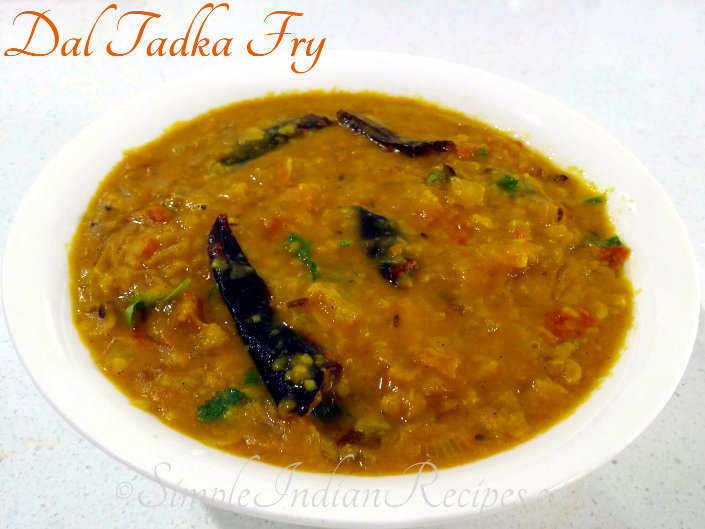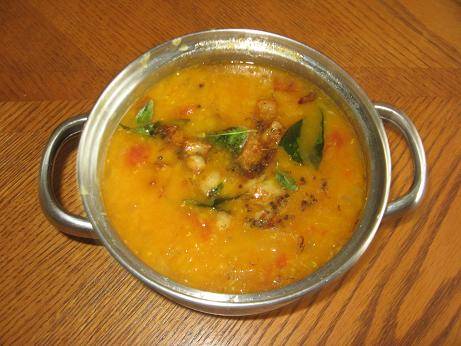- Submitted by Dahlia
(Dal Tadka, Parippu Curry, Paruppu Kulambu, Pappu)

Jump to recipe ↓
Dal refers to a thick stew made with dry split beans (pulses). It is a traditional dish made in india and pakistan. It is usually served with rice or roti and papad with a dollop of ghee to enhance the flavour. In most Indian houses, dal is made almost everyday. A slight variation of dal is the sambhar made in south india. Most commonly made dal is the one using toor dal, which is nothing but dry split yellow lentils. Other variations of dals are made with red lentils (masoor dal), moong dal, urad dal, channa dal and even with whole beans(green gram, rajma, channa etc) also known as saboot dals.
To prepare dal, first start by boiling the dried lentils with salt, turmeric powder and required amount of water. After the dal is nicely cooked, a tadka (or tempering) is added on top. This is the key to the flavour of the dal. Sometimes different vegetables are added with the dal like raw mango, tomatoes, spinach, fenugreek leaves, bottle gourd, ridge gourd, cucumber, zucchini, pumpkin, drumstick etc.
Today I want to share the basic dal recipe which is most commonly made throughout India. It is known as dal tadka in North India. In Tamilnadu, it is called 'Paruppu Kulambu' or 'Killi Potta Sambar' and in Kerala it is called 'Parippu Curry'. It is just plain cooked dal with the basic tempering. Other varieties I will share one by one in future.
Well talking about that I have always had a confusion over Dal Tadka and Dal Fry. Being a South Indian, I had to rely on my friends and the internet for answers. This is what I found. Please feel free to share your ideas.
Dal Tadka :
Here the dal is cooked first until soft. It is also cooked for a while along with the tomatoes, onions and any other vegetables that may be added. When done, it is taken in the serving dish. Finally just before serving, a tempering is added on top. The tempering is usually made with ghee and spices like cumin seeds, asafoetida, mustard seeds, curry leaves etc. The tempering may vary but the point is to have the tempering done in the very last minute so that the aroma of the flavoured oil that floats on top really stands out. In restaurants, dal tadka sometimes also comes with a dhungar, where the dal is infused with smoky flavour using burnt charcoal and some ghee.
Dal Fry :
Coming to the Dal fry, we start this also by cooking the lentils first. The onions, tomatoes, garlic etc. are fried in the tempering oil nicely and then added to the dal. Dal fry may or may not have a separate tadka.
I have explained both methods in detail below.
Recipe for Everyday Dal
Preparation time: 30 minutes
Cooking time: 20 minutes
Serves: 4
Ingredients
- Dal - 1 cup (Toor dal is commonly used but you can use any type of dal or a mix of dals each day)
- Onion - 1 (chopped)
- Green Chillies - 2 (chopped)
- Tomato - 1
- Salt - to taste
- Turmeric powder - 1/4 tsp
- Cilantro - handful finely chopped
Tempering (Tadka)
- Oil - 2 tbsp
- Dry red chillies - 2
- Mustard seeds - 1/4 tsp
- Cumin seeds - 1/4 tsp
- Asafoetida - a pinch
- Garlic - 4 cloves (crushed or chopped)
- Curry Leaves - few
- Ghee - 1 tbsp
Method 1: (Dal Fry)
- Pressure cook the dal until it is nicely cooked but not mushy for about 2 whistles and keep aside. (Traditionally toor dal is used but you may use any other lentils or a combination of lentils. This will make it different in taste, texture and interesting each day.)
- Heat oil in a pan and splutter the mustard seeds, cumin seeds, curry leaves and dry red chillies.
- Add asafoetida and turmeric powder to this.
- Next add finely chopped garlic cloves and fry it on low flame till it turns brown.
- Next add the onions and saute for a while. Add some chopped tomatoes and saute.
- Add the cooked dal required amount of salt and let it cook for 10 minutes till all the flavour blends. Add water as needed to your desired thickness.
- Add finely chopped coriander leaves, a dollop of ghee and switch off.
Method 2: (Dal Tadka)
- Pressure cook the dal along with the onions, turmeric powder, green chillies, salt and tomato.
- Cook everything together with enough water for 2 whistles. Note :- The normal ratio of water for a thick dal is 1:3 i.e 3 cups of water for 1 cup of dal. If you want a thinner dal, increase the amount of water.
- After the pressure comes down, open the cooker and add the tadka. For the tadka or tempering, heat oil/ ghee in a pan, splutter the mustard seeds and cumin seeds. Add dry red chillies, asafoetida, curry leaves and finely chopped garlic cloves.
- Cook on low flame till the garlic is cooked. Add this tadka on top of the dal for flavour and as a nice garnish. Also add finely chopped cilantro .
Variations
- Some people like to mash up the dal with a masher before adding the tadka.
- Some sourness is always added in some form to the dal. In the above recipe, we have added tomatoes. It can be substituted with amchoor powder, raw mangoes, lemon juice or tamarind juice.
- I prefer dal plain but some people like to add 1/2 tsp of red chili powder or 1/4 tsp of garam masala to the dal.
Serving Dal
- Dal is typically served with white rice, jeera pulao, naan, roti, phulka etc. It is a must have in the restaurant thali meals.

More Dal Recipes